
- Peterborough


How to Write Academic Reviews
- What is a review?
- Common problems with academic reviews
- Getting started: approaches to reading and notetaking
- Understanding and analyzing the work
- Organizing and writing the review
What Is a Review?
A scholarly review describes, analyzes, and evaluates an article, book, film, or performance (through this guide we will use the term “work” to refer to the text or piece to be reviewed). A review also shows how a work fits into its disciplines and explains the value or contribution of the work to the field.
Reviews play an important role in scholarship. They give scholars the opportunity to respond to one another’s research, ideas and interpretations. They also provide an up-to-date view of a discipline. We recommend you seek out reviews in current scholarly journals to become familiar with recent scholarship on a topic and to understand the forms review writing takes in your discipline. Published scholarly reviews are helpful models for beginner review-writers. However, we remind you that you are to write your own assessment of the work, not rely on the assessment from a review you found in a journal or on a blog.
As a review-writer, your objective is to:
- understand a work on its own terms (analyze it)
- bring your own knowledge to bear on a work (respond to it)
- critique the work while considering validity, truth, and slant (evaluate it)
- place the work in context (compare it to other works).
Common Problems with Academic Reviews
A review is not a research paper.
Rather than a research paper on the subject of the work,an academic review is an evaluation about the work’s message, strengths, and value. For example, a review of Finis Dunaway’s Seeing Green would not include your own research about media coverage of the environmental movement; instead, your review would assess Dunaway’s argument and its significance to the field.
A review is not a summary
It is important to synthesize the contents and significance of the work you review, but the main purpose of a review is to evaluate, critically analyze, or comment on the text. Keep your summary of the work brief, and make specific references to its message and evidence in your assessment of the work.
A review is not an off-the-cuff, unfair personal response
An effective review must be fair and accurate. It is important to see what is actually in front of you when your first reaction to the tone, argument, or subject of what you are reviewing is extremely negative or positive.
You will present your personal views on the work, but they must be explained and supported with evidence. Rather than writing, “I thought the book was interesting,” you can explain why the book was interesting and how it might offer new insights or important ideas. Further, you can expand on a statement such as “The movie was boring,” by explaining how it failed to interest you and pointing toward specific disappointing moments.
Getting Started: Approaches to Reading and Notetaking
Pre-reading.
Pre-reading helps a reader to see a book as a whole. Often, the acknowledgments, preface, and table of contents of a book offer insights about the book’s purpose and direction. Take time before you begin chapter one to read the introduction and conclusion, examine chapter titles, and to explore the index or references pages.
Read more about strategies for critical and efficient reading
Reverse outline
A reverse outline helps a reader analyze the content and argument of a work of non-fiction. Read each section of a text carefully and write down two things: 1) the main point or idea, and 2) its function in the text. In other words, write down what each section says and what it does. This will help you to see how the author develops their argument and uses evidence for support.
Double-entry notebook
In its simplest form, the double-entry notebook separates a page into two columns. In one column, you make observations about the work. In the other, you note your responses to the work. This notetaking method has two advantages. It forces you to make both sorts of notes — notes about the work and notes about your reaction to the work — and it helps you to distinguish between the two.
Whatever method of notetaking you choose, do take notes, even if these are scribbles in the margin. If you don’t, you might rely too heavily on the words, argument, or order of what you are reviewing when you come to write your review.
Understand and Analyze the Work
It is extremely important to work toward seeing a clear and accurate picture of a work. One approach is to try to suspend your judgment for a while, focusing instead on describing or outlining a text. A student once described this as listening to the author’s voice rather than to their own.
Ask questions to support your understanding of the work.
Questions for Works of Non-Fiction
- What is the subject/topic of the work? What key ideas do you think you should describe in your review?
- What is the thesis, main theme, or main point?
- What major claims or conclusions does the author make? What issues does the work illuminate?
- What is the structure of the work? How does the author build their argument?
- What sources does the author consult? What evidence is used to support claims? Do these sources in any way “predetermine” certain conclusions?
- Is there any claim for which the evidence presented is insufficient or slight? Do any conclusions rest on evidence that may be atypical?
- How is the argument developed? How do the claims relate? What does the conclusion reveal?
Questions for Works of Fiction
- What is the main theme or message? What issues does the book illuminate?
- How does the work proceed? How does the author build their plot?
- What kind of language, descriptions, or sections of plot alert you to the themes and significance of the book?
- What does the conclusion reveal when compared with the beginning?
Read Critically
Being critical does not mean criticizing. It means asking questions and formulating answers. Critical reading is not reading with a “bad attitude.” Critical readers do not reject a text or take a negative approach to it; they inquire about a text, an author, themselves, and the context surrounding all three, and they attempt to understand how and why the author has made the particular choices they have.
Think about the Author
You can often tell a lot about an author by examining a text closely, but sometimes it helps to do a little extra research. Here are some questions about the author that would be useful to keep in mind when you are reading a text critically:
- Who is the author? What else has the author written?
- What does the author do? What experiences of the author’s might influence the writing of this book?
- What is the author’s main purpose or goal for the text? Why did they write it and what do they want to achieve?
- Does the author indicate what contribution the text makes to scholarship or literature? What does the author say about their point of view or method of approaching the subject? In other words, what position does the author take?
Think about Yourself
Because you are doing the interpreting and evaluating of a text, it is important to examine your own perspective, assumptions, and knowledge (positionality) in relation to the text. One way to do this is by writing a position statement that outlines your view of the subject of the work you are reviewing. What do you know, believe, or assume about this subject? What in your life might influence your approach to this text?
Here are some prompts that might help you generate a personal response to a book:
- I agree that ... because ...
- I disagree that ... because ...
- I don’t understand ...
- This reminds me of …
- I’m surprised by …
Another way to examine your thoughts in relation to a text is to note your initial response to the work. Consider your experience of the text – did you like it? Why or why not?
- What did I feel when I read this book? Why?
- How did I experience the style or tone of the author? How would I characterize each?
- What questions would I ask this author if I could?
- For me, what are the three best things about this book? The three worst things? Why?
Consider Context
A reviewer needs to examine the context of the book to arrive at a fair understanding and evaluation of its contents and importance. Context may include the scholarship to which this book responds or the author’s personal motive for writing. Or perhaps the context is simply contemporary society or today’s headlines. It is certainly important to consider how the work relates to the course that requires the review.
Here are some useful questions:
- What are the connections between this work and others on similar subjects? How does it relate to core concepts in my course or my discipline?
- What is the scholarly or social significance of this work? What contribution does it make to our understanding?
- What, of relevance, is missing from the work: certain kinds of evidence or methods of analysis/development? A particular theoretical approach? The experiences of certain groups?
- What other perspectives or conclusions are possible?
Once you have taken the time to thoroughly understand and analyze the work, you will have a clear perspective on its strengths and weaknesses and its value within the field. Take time to categorize your ideas and develop an outline; this will ensure your review is well organized and clear.
Organizing and Writing the Review
A review is organized around an assessment of the work or a focused message about its value to the field. Revisit your notes and consider your responses to your questions from critical reading to develop a clear statement that evaluates the work and provides an explanation for that evaluation.
For example:
X is an important work because it provides a new perspective on . . .
X’s argument is compelling because . . . ; however, it fails to address . . .
Although X claims to . . ., they make assumptions about . . . , which diminishes the impact . . .
This statement or evaluation is presented in the introduction. The body of the review works to support or explain your assessment; organize your key ideas or supporting arguments into paragraphs and use evidence from the book, article, or film to demonstrate how the work is (or is not) effective, compelling, provocative, novel, or informative.
As with all scholarly writing, a well-organized structure supports the clarity of your review. There is not a rigid formula for organization, but you may find the following guidelines to be helpful. Note that reviews do not typically include subheadings; the headings listed here serve to help you think about the main sections of your academic review.
Introduction
Introduce the work, the author (or director/producer), and the points you intend to make about this work. In addition, you should
- give relevant bibliographic information
- give the reader a clear idea of the nature, scope, and significance of the work
- indicate your evaluation of the work in a clear 1-2 sentence thesis statement
Provide background information to help your readers understand the importance of the work or the reasons for your appraisal. Background information could include:
- why the issue examined is of current interest
- other scholarship about this subject
- the author’s perspective, methodology, purpose
- the circumstances under which the book was created
Sample Introduction
Within educational research, much attention has been given to the importance of diversity and equity, and the literature is rife with studies detailing the best ways to create environments that are supportive of diverse students. In “Guidance Matters,” however, Carpenter and Diem (2015) examined these concepts in a less-studied source: policy documents related to leadership training. Using discourse analysis, they explored the ways in which government policies concerning the training of educational administrators discussed issues of diversity and equity. While their innovative methods allowed them to reveal the ways in which current policy promotes superficial platitudes to diversity rather than a deep commitment to promoting social justice, their data analysis left many of their identified themes vague and their discussion did not provide a clear explanation of the applications of their findings.
What works in this sample introduction:
- The nature of the larger issue, how best to create diversity and equity within educational environments, is clearly laid out.
- The paragraph clearly introduces the authors and study being reviewed and succinctly explains how they have addressed the larger issue of equity and diversity in a unique way.
- The paragraph ends with a clear thesis that outlines the strengths and weaknesses of the work.
Summary of the Work
Keep the summary of the work short! A paragraph or two should be sufficient. Summarize its contents very briefly and focus on:
- the purpose of the work
- the main points of the work
- the ideas, themes, or arguments that you will evaluate or discuss in the review
Analysis and Evaluation
Analyze and explain the significance of the main points of the work. Evaluate the work, answering questions such as the following:
- Does the work do what its author claimed it would?
- Is the work valid and accurate?
- How does the work fit into scholarship in the field?
- What are your reasons for agreeing, disagreeing, liking, disliking, believing, disbelieving?
Note that this section will take up the bulk of your review and should be organized into paragraphs. Because this form of writing typically does not use subheadings, strong paragraphing, particularly the use of clear topic sentences, is essential. Read more on paragraphing.
Reviews are informed by your critical reading or viewing of a work; therefore you need to include specific evidence from the work to support your claims about its message and its impact. Your writing and your assessment of the work will be most effective if you paraphrase or summarize the evidence you use, rather than relying on direct quotations. Be sure to follow the rules for citation in your discipline. Read more on paraphrasing and summarizing.
Sample Body Paragraph
One of the strengths of Carpenter and Diem’s (2015) study was innovative use of and nuanced explanation of discourse analysis. Critiquing much of the research on policy for its positivist promises of “value neutral and empirically objective” (p. 518) findings, Carpenter and Diem (2015) argued that discourse theory can provide an important lens through which to view policy and its relationship to educational outcomes. By interrogating the “inscribed discourses of policy making” (p. 518), they showed how policy language constructs particular social meanings of concepts such as diversity and equity. Significantly, this analysis was not simply about the language used within documents; instead, Carpenter and Diem (2015) argued that the language used was directly related to reality. Their “study examine[d] how dominant discourses related to equity, and their concretization within guiding policy documents, may shape the ways in which states, local school districts, and educational leaders are asked to consider these issues in their everyday practice” (Carpenter & Diem, 2015, p. 519). Thus, through the use of discourse theory, Carpenter and Diem (2015) framed policy language, which some might consider abstract or distant from daily life, as directly connected to the experience of educational leaders.
What works in this sample body paragraph:
- The paragraph begins with a clear topic sentence that connects directly to a strength mentioned in the thesis of the review.
- The paragraph provides specific details and examples to support how and why their methods are innovative.
- The direct quotations used are short and properly integrated into the sentences.
The paragraph concludes by explaining the significance of the innovative methods to the larger work.
Conclusion and Recommendation
Give your overall assessment of the work. Explain the larger significance of your assessment. Consider who would benefit from engaging with this work.
- Future Students
- International
Current Students

Academic Success Centre
- Writing & study resources
- Plagiarism checker (Turnitin)
- Get feedback on your paper
- Book a tutoring appointment
- Become a peer tutor
- Academic writing
Upcoming academic writing workshops
Organize that paper — create an outline.
Dates:
- TBA (contact us to schedule a workshop!)
Learn strategies to craft an outline that will get your paper written.
Writing thesis statements — Getting started
- October 29, 2024, from 11:15 AM to 11:45 AM join online in Zoom
- November 14, 2024, from 1:15 PM to 1:45 PM join online in Zoom
Learn the ins and outs of creating a powerful and effective thesis statement.
Writing Introductions and Conclusions
Have you always wondered what should go in your introduction and conclusion? Wonder no more! Come to this workshop to learn how to write effective introductions and conclusions.
- Academic Integrity Week at UFV
- Procrastination Awareness Week (PAW)
- De-stress Fest
- Academic integrity
- Citation style guides
- Grammar & mechanics
- Study strategies
- Book an individual tutoring appointment
- Join a drop-in tutoring session
- Book an appointment with a Learning Strategist
- Find a workshop
- Check your work for plagiarism (Turnitin)
- Get feedback on your assignment (WriteAway)
- Virtual Open Writing Lab (for everyone) — VOWəL
- Blackboard (myClass) tutorials
- Request academic support services
- 604-854-4573
Future students
Academic Calendar Find your program How to Apply Book a tour Transfer credits Tuition & fees FAQs
Ask a question A to Z websites Directory Emergency contacts IT Service Desk Reset your password Safety & Security myUFV
Academic Advising Centre Bookstore Register for courses Safe Student Community Shuttle bus Student services Timetables myClass CIVL Radio
Accessible UFV Accreditation Careers at UFV Cascades Athletics Make a gift Events Human Resources News Contact us
- Call for Articles
- Login

Facing Difficulty Writing an Academic Essay? — Here is your one-stop solution!
Academic writing is an important aspect of higher education, as it helps to develop critical thinking, research skills, and the ability to communicate complex ideas effectively. However, for many people, writing an academic essay can be a daunting task. In this blog, we will take you through the process of writing an academic essay, step by step, so that you can approach your next writing assignment with confidence.
From understanding the assignment and researching the topic to developing an outline and revising your work, we will cover all of the key elements of the academic essay-writing process. We will also provide tips and tricks for overcoming common challenges and improving your writing skills. Whether you’re just starting out in your academic career, or you’re a seasoned pro looking to refine your writing skills, this blog has something to offer.
So, if you’re ready to take your academic writing to the next level, read on and discover how to write an academic essay that will impress your readers and help you achieve your goals.
Table of Contents
Writing an Academic Essay
1. introduction.
The introduction is one of the most important parts of an academic essay, as it sets the stage for what’s to come. The introduction should provide background information on the topic, establish the purpose of the essay, and clearly state your thesis. The purpose of the introduction is to engage your reader and make them want to continue reading.
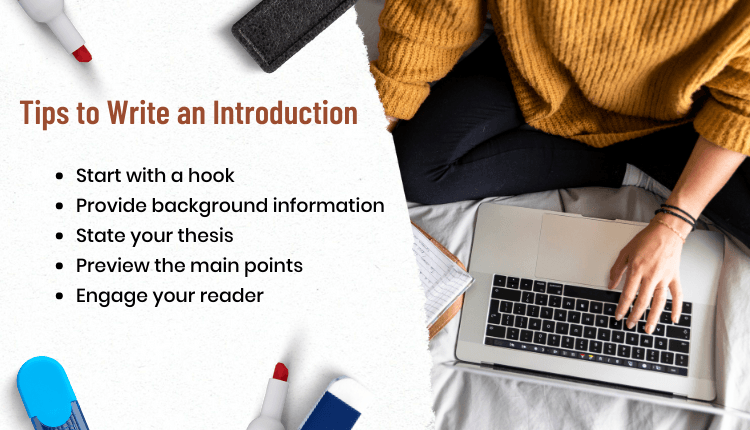
Here are some key steps to writing a strong introduction:
1. Start with a hook
Begin your introduction with a hook that will grab the reader’s attention. This could be a quote, a statistic, or an interesting fact related to the topic.
2. Provide background information
After the hook, provide some background information on the topic to give context to the reader. This information should be relevant to the topic and help the reader understand why it’s important.
3. State your thesis
The thesis statement is a clear and concise statement of what you will argue in your essay. It should be placed near the end of the introduction and should reflect the focus of your essay.
4. Preview the main points
Preview the main points of your essay, so the reader knows what to expect. This will give your reader a roadmap for what is to come and will help you to stay focused as you write your essay.
5. Engage your reader
The introduction should engage your reader and make them want to continue reading. Avoid using too much technical language or jargon, and instead, focus on making your introduction accessible and interesting.
Writing a strong introduction to an academic essay is crucial for engaging your reader and setting the stage for what’s to come. By starting with a hook, providing background information, stating your thesis, previewing the main points, and engaging your reader, you will be well on your way to writing a strong academic essay.
2. Literature Review
The literature review is a critical component of an academic essay, as it provides a foundation for the rest of your research. The purpose of a literature review is to summarize and synthesize previous research on the topic and to identify gaps in the existing knowledge. The literature review should be more than just a list of articles and books, but rather an evaluation of the relevant literature.
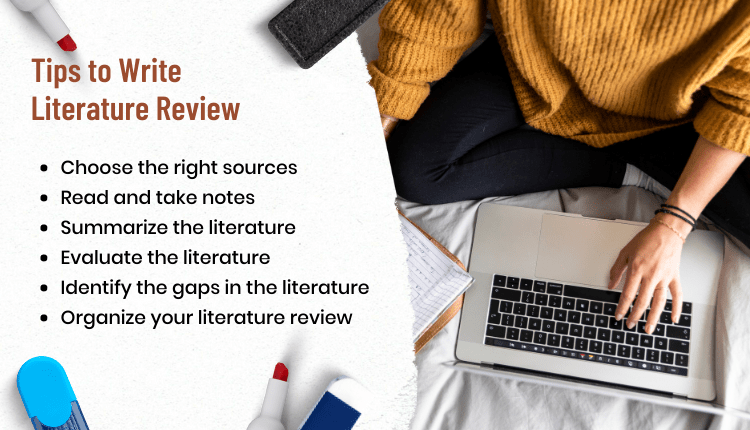
Here are some key steps to writing a literature review :
1. Choose the right sources
Start by identifying relevant sources for your literature review. This may include academic journals, books, conference proceedings, and theses. Make sure to choose only the most relevant and up-to-date sources.
2. Read and take notes
Once you’ve identified your sources, it’s time to read and take notes. Use a system to keep track of the information and be sure to note the author, date, and key findings of each source.
3. Summarize the literature
In your literature review, you should summarize the key findings of each source, highlighting their relevance to your research. You should also synthesize the information, looking for patterns, similarities, and differences among the sources.
4. Evaluate the literature
A strong literature review should not just summarize the sources, but also evaluate them. This means examining their strengths and weaknesses and assessing their relevance to your research question .
5. Identify gaps in the literature
As you evaluate the sources, look for gaps in the existing knowledge and areas where further research is needed. This will help you to identify the significance of your research and justify the need for your study.
6. Organize your literature review
Once you’ve completed your evaluation, you should organize your literature review clearly and logically. This could be chronologically, thematically, or based on methodology.
By choosing the right sources, reading and taking notes, summarizing and evaluating the literature, identifying gaps, and organizing your review, you will be able to provide a thorough and well-supported foundation for the rest of your essay.
3. Methodology
The methodology section of an academic essay is where you describe the methods you used to conduct your research. This section is an opportunity to explain the steps you took to answer your research question and to justify why you chose these methods. The methodology should be detailed, precise, and transparent so that others can understand and replicate your study if necessary.
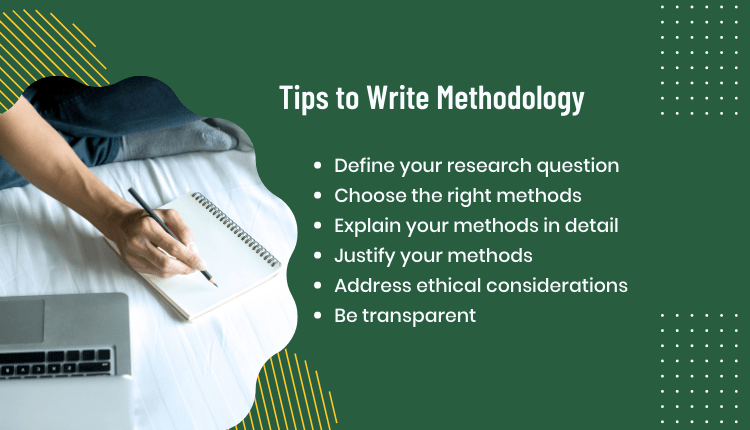
Here are some key steps to writing a strong methodology:
1. Define your research question
Before writing your methodology, you should have a clear understanding of your research question. This will guide the choice of methods you use and the information you collect.
2. Choose the right methods
The choice of methods should be guided by the research question. For example, if you’re conducting a survey, you would use a different method than if you were conducting a case study. Consider the strengths and limitations of each method, and choose the one that is best suited to your research question.
3. Explain your methods in detail
In your methodology, you should describe your methods in detail, so that others can understand how you conducted your research. This should include information on the sample size, how you collected the data, and any instruments or techniques you used.
4. Justify your methods
You should justify why you chose the methods you used and how they are appropriate for answering your research question. This might involve a discussion of the limitations of your methods and how they affect the results.
5. Address ethical considerations
If your research involved human subjects, you must address ethical considerations in your methodology. This might include information on informed consent, data confidentiality, and any potential risks to participants.
6. Be transparent
Your methodology should be transparent and honest so that others can understand and replicate your study if necessary. Be sure to report all of the methods you used, even if the results were not what you expected.
By defining your research question, choosing the right methods, explaining your methods in detail, justifying your methods, addressing ethical considerations, and being transparent, you will be able to provide a thorough and well-supported methodology for your essay.
The results section of an academic essay is where you present the findings of your research. This section should be clear, concise, and objective, and should present the data without any interpretation or discussion. The results should be organized logically and should include tables, figures, and other visual aids as necessary.

Here are some key steps to writing a strong results section:
1. Summarize the data
The first step in writing the results section is to summarize the data you collected. This might involve calculating means, standard deviations, and other descriptive statistics , depending on the type of data you collected.
2. Organize the results
This might involve presenting the results for each hypothesis, each research question, or each variable, depending on the nature of your study.
3. Use visual aids
Visual aids, such as tables and figures , can help to clarify and simplify the results. Make sure to label each visual aid clearly, and provide a caption that explains what the visual aid is showing.
4. Be objective
The results section should be objective, presenting the data without any interpretation or discussion. The interpretation of the results should be left to the discussion section.
5. Report results accurately
The results section should report the results accurately and precisely. This might involve rounding numbers to a specified number of decimal places, or using appropriate units of measurement.
In summary, by summarizing the data, organizing the results, using visual aids, being objective, and reporting the results accurately, you will be able to present your findings in a clear and compelling manner.
5. Discussion
The discussion section of an academic essay is where you interpret the results of your research and relate them to your research question and the broader literature. This section is an opportunity to conclude, make recommendations, and reflect on the strengths and limitations of your study. The discussion should be well-organized and should provide a clear and concise interpretation of the results.

Here are some key steps to writing a strong discussion section:
1. Interpret the results
The first step in writing the discussion section is to interpret the results of your study. This might involve comparing your results to previous research, explaining any unexpected results, and drawing conclusions about the implications of your findings.
2. Relate the results to your research question
The discussion should relate the results of your study to your research question, demonstrating how the results answer the question and providing insights into the topic.
3. Evaluate the strengths and limitations of your study
The discussion should include an evaluation of the strengths and limitations of your study, addressing any limitations that might affect the validity of the results, and suggesting areas for future research.
4. Draw conclusions
The discussion should conclude the results of the study, make recommendations based on the findings, and discuss the implications for future research.
5. Consider the broader context
The discussion should consider the broader context of the research, relating the findings to the broader literature and making connections to other related fields.

6. Write clearly and concisely
The discussion should be well-written and easy to understand, using clear and concise language. Avoid using technical jargon, and make sure to define any terms that may be unfamiliar to your reader.
6. Conclusion
The conclusion of an academic essay is the final section in which you summarize the key points of your argument and provide closure to your reader. This section should be concise and to the point, reiterating the main points of your essay and providing a final perspective on your topic. The conclusion should also reflect on the implications of your research, considering the broader context of your study and its contributions to the field.
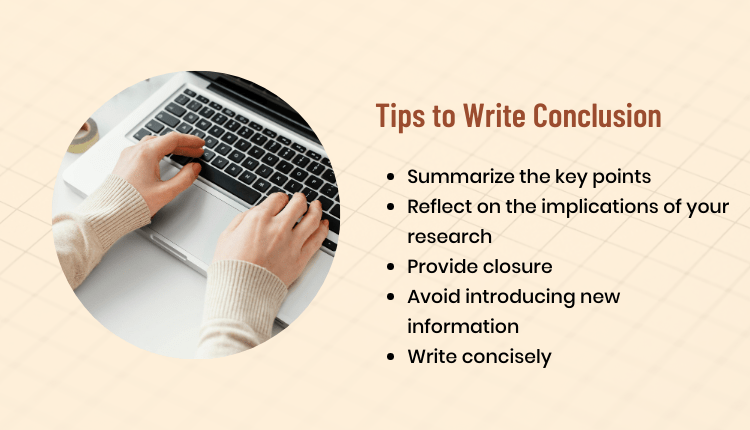
Here are some key steps to writing a strong conclusion:
1. Summarize the key points
The first step in writing the conclusion is to summarize the key points of your essay. This might involve restating your research question, summarizing your findings, and reiterating your arguments.
2. Reflect on the implications of your research
The conclusion should reflect on the implications of your research, considering the broader context of your study and its contributions to the field. This might involve discussing the potential applications of your findings, considering any ethical implications, or discussing future directions for research.
3. Provide closure
The conclusion should provide closure to your reader, bringing your argument to a logical end and tying up any loose ends. This might involve suggesting a conclusion based on your research, or providing a final perspective on your topic.
4. Avoid introducing new information
The conclusion should avoid introducing new information or arguments that were not discussed in the body of your essay. This might confuse your reader and undermine the coherence of your argument.
5. Write concisely
The conclusion should be concise, using clear and concise language to summarize the key points of your essay. Avoid using technical jargon, and make sure to write in a way that is easy for your reader to understand.
By summarizing the key points, reflecting on the implications of your research, providing closure, avoiding introducing new information, and writing concisely, you will be able to provide a compelling conclusion to your argument.
7. References
The references section of an academic essay is a crucial component that provides a list of the sources you used in your research and writing. The purpose of the references section is to give credit to the authors whose work you have used, to provide evidence for your arguments, and to support the validity of your research.

Here are some key steps to writing a strong references section:
1. Follow a specific citation style
The first step in writing the references section is to follow a specific citation style. There are several citation styles used in academic writing, including APA , MLA , and Chicago , and it is important to choose the one that is appropriate for your discipline and the type of essay you are writing.
2. Cite all sources used in your essay
The references section should include a citation for all sources that you used in your essay, including books, journal articles, websites, and other types of sources.
3. Follow the format guidelines
The references section should be formatted according to the specific citation style that you have chosen. This might involve including information such as the author’s name, the title of the source, the publication date, and the page numbers for any direct quotes or paraphrased material.
4. Alphabetize the references
The references section should be alphabetized according to the author’s last name, or the first word of the title for sources without authors.
5. Check for accuracy
Before submitting your essay, make sure to check the references section for accuracy, verifying that all of the information is correct and that all of the sources are cited properly.
By following a specific citation style, citing all sources used in your essay, following the format guidelines, alphabetizing the references, and checking for accuracy, you will be able to provide a comprehensive and well-documented references section for your essay.
8. Appendices
The appendices section of an academic essay is an optional component that provides additional information that supports the main argument or research findings. This section might include materials such as graphs, tables, maps, images, or other types of data or supplementary information.
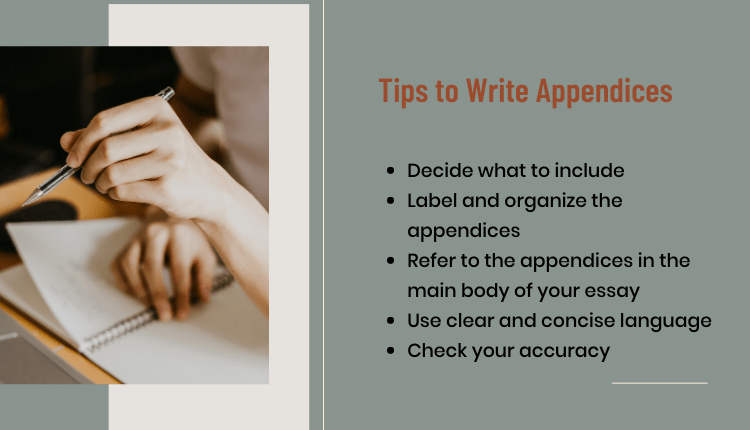
Here are some key steps to writing a strong appendices section:
1. Decide what to include
The first step in writing the appendices section is to decide what to include. This might involve evaluating the relevance of different types of information and determining which information is necessary to support your argument.
2. Label and organize the appendices
The appendices should be labeled and organized clearly and consistently, making it easy for the reader to understand the information being presented. This might involve including a title or description for each appendix, and numbering the appendices in a logical order.
3. Refer to the appendices in the main body of your essay
The appendices should be referred to in the main body of your essay, helping to connect the appendices to your argument. This might involve including a reference to the appendix in your text, or including a cross-reference to the appendix in your table of contents.
4. Use clear and concise language
The appendices should be written using clear and concise language, making it easy for the reader to understand the information being presented. Avoid using technical jargon, and make sure to write in a way that is accessible to your reader.
Before submitting your essay, make sure to check the appendices section for accuracy, verifying that all of the information is correct and that all of the tables, graphs, and other materials are properly labeled and organized.
By deciding what to include, labeling and organizing the appendices, referring to the appendices in the main body of your essay, using clear and concise language, and checking for accuracy, you will be able to provide a comprehensive and well-documented appendices section for your essay.
In Conclusion
Writing an academic essay is a complex and challenging task that requires careful planning, research, writing, and revision. From developing a strong thesis statement and researching the topic to writing the introduction, literature review, methodology, results, discussion, conclusion, and references, each step in the essay writing process requires attention to detail and a commitment to producing a high-quality essay.
By following the guidelines and tips outlined in this blog, you will be able to write a clear and well-structured essay that effectively communicates your argument, supports your claims with evidence, and meets the expectations of your reader.
In conclusion, writing an academic essay is a multi-step process that requires time, effort, and dedication. However, by breaking the process down into manageable steps, and by focusing on the key elements of writing an effective essay, you will be able to produce a high-quality essay that meets the expectations of your reader and contributes to your academic or professional success.
The best info ever thanks keep going like this 👌 🙌 👏 👍
It’s clearly and interesting work. I will use ir for My study and work i’m education un Patagonia, Argentina. Thanks Shrutika.
I love the content
Thank you for the update and enlightened
Rate this article Cancel Reply
Your email address will not be published.

Enago Academy's Most Popular Articles

- Reporting Research
Academic Essay Writing Made Simple: 4 types and tips
The pen is mightier than the sword, they say, and nowhere is this more evident…

- AI in Academia
- Trending Now
Simplifying the Literature Review Journey — A comparative analysis of 5 AI summarization tools
Imagine having to skim through and read mountains of research papers and books, only to…

Choosing the Right Analytical Approach: Thematic analysis vs. content analysis for data interpretation
In research, choosing the right approach to understand data is crucial for deriving meaningful insights.…

Comparing Cross Sectional and Longitudinal Studies: 5 steps for choosing the right approach
The process of choosing the right research design can put ourselves at the crossroads of…

- Career Corner
Unlocking the Power of Networking in Academic Conferences
Embarking on your first academic conference experience? Fear not, we got you covered! Academic conferences…
Choosing the Right Analytical Approach: Thematic analysis vs. content analysis for…
Comparing Cross Sectional and Longitudinal Studies: 5 steps for choosing the right…
Research Recommendations – Guiding policy-makers for evidence-based decision making

Sign-up to read more
Subscribe for free to get unrestricted access to all our resources on research writing and academic publishing including:
- 2000+ blog articles
- 50+ Webinars
- 10+ Expert podcasts
- 50+ Infographics
- 10+ Checklists
- Research Guides
We hate spam too. We promise to protect your privacy and never spam you.
- Plagiarism Checker
- AI Content Detector
- Academic Editing
- Publication Support Services
- Thesis Editing
- Enago Reports
- Journal Finder
- Thought Leadership
- Publishing Research
- Promoting Research
- Diversity and Inclusion
- Industry News
- Al in Academia
- Other Resources
- Infographics
- Enago Learn
- On-Demand Webinar
- Open Access Week
- Peer Review Week
- Publication Integrity Week
- Conference Videos
- Call for speakers
- Author Training
I am looking for Editing/ Proofreading services for my manuscript Tentative date of next journal submission:

What features do you prefer in a plagiarism detector? (Select all that apply)

Academic Writing
- Writing Guides
- Academic Writing Basics
Understand Your Assignment
Understand the context of your writing, practice writing as a process, peer review: enhancing your writing through collaboration.
- Writing Tutorial Basics: A Guide for Peer Tutors in the Academic Commons
- Resources for Writing Consultants and Peer Tutors
- Faculty Toolkit: Embedding Peer Writing Tutorials in Undergraduate Course Assignments
- Faculty Toolkit: Embedding Writing Consultations in Graduate and Online Course Assignments
Understanding Your Assignment: The Crucial First Step 🎓📝
Comprehending your assignment thoroughly is fundamental to academic writing success. This process involves careful reading, analysis, and often, clarification with your instructor. Here are some key steps to assignment understanding:
1. Read the Prompt Multiple Times 👀📚
- First read : Gain an overall sense of the assignment
- Second read : Identify key tasks and requirements
- Third read : Note specific details, constraints, and formatting instructions
2. Identify Key Terms and Concepts 🔑📖
- Highlight action words (e.g., analyze, compare, evaluate)
- Circle content-specific terms you may need to research
- Note unfamiliar terms to clarify with your professor
3. Break Down the Assignment ✂️📊
- Identify the main task(s) you need to complete
- List any subtasks or components
- Note the required word count or page length
4. Understand the Purpose 🎯💡
- Consider why this assignment was given
- Reflect on how it relates to course learning objectives
- Identify the skills or knowledge you're meant to demonstrate
5. Clarify Expectations 📏🔍
- Review the grading rubric if provided
- Note any specific sources or number of sources required
- Understand the expected format and citation style
6. Ask Questions ❓🗨️
Don't hesitate to seek clarification from your professor:
- Prepare specific questions about unclear aspects
- Confirm your understanding of the main task(s)
Self-Assessment Checklist ✅
Use this checklist to ensure you've fully understood your assignment:
- I can state the main task(s) of the assignment in my own words
- I've identified all the key components I need to include
- I understand the format and citation style required
- I know how my work will be evaluated (grading criteria)
- I'm clear on the deadline and submission method
- I've clarified any uncertainties with my professor
Common Pitfalls to Avoid ⚠️
- Overlooking important details in the prompt
- Misinterpreting key terms or concepts
- Failing to address all parts of a multi-part question
- Not aligning your work with the stated purpose of the assignment
Remember: Taking the time to thoroughly understand your assignment at the outset can save you time and frustration later in the writing process.
Need additional guidance? Don't hesitate to schedule an appointment with a Peer Tutor or Writing Consultant for personalized support in decoding your assignment.
Understanding the Context of Your Writing 🖊️🎓
Understanding the context for your writing, or "rhetorical situation," is crucial for effective academic writing at all levels. It involves considering the purpose, audience, context, and medium of your writing. By mastering these elements, you can make strategic decisions about how to present your arguments and structure your writing to communicate most effectively in your academic and professional contexts.
The video above provides a clear explanation of the rhetorical situation and its importance in effective communication. While it uses everyday examples, the concepts are directly applicable to academic writing. Understanding these elements will help you craft more persuasive and effective scholarly works.
What is Rhetorical Situation? 🤔
A rhetorical situation refers to any set of circumstances involving at least one person using communication to modify the perspective of at least one other person. Here are five key elements of rhetorical situations:
- In academic writing, this could be your essay, thesis, dissertation, or journal article
- Consider how the format and structure of your text align with your field's conventions
- As a student, consider your developing expertise and authority in your field
- Reflect on how to establish credibility through your writing and research
- Identify your primary readers (e.g., professors, committee members, journal reviewers, fellow scholars)
- Consider their background knowledge, expectations, and potential biases
- Clarify your goals (e.g., to inform, persuade, contribute new knowledge)
- Align your writing strategies with your academic and professional objectives
- Consider the current state of research in your field
- Reflect on how your work fits into ongoing scholarly conversations
Checklist for Understanding the Context of Your Writing Assignment or Task ✅
Use this checklist as you plan, draft, and revise your academic writing to ensure you're considering all aspects of the rhetorical situation:
Text (Logos) 📄
- What type of document am I creating?
- What are the conventions of this genre?
- How should I structure my arguments?
Author (Ethos) ✍️
- What are my credentials relevant to this topic?
- How can I establish my credibility?
- What potential biases should I be aware of?
Audience (Pathos) 👥
- Who is my primary audience?
- What do they already know about my topic?
- What are their values and expectations?
- How can I appeal to their emotions or interests?
Purpose (Telos) 🎯
- What is my main goal in writing this?
- Am I trying to inform, persuade, or entertain?
- What do I want my audience to do or think after reading?
Setting (Kairos) 🌍
- When and where will this be read?
- What current events or trends are relevant?
- How does the medium (e.g., journal article, blog post) affect my approach?
Community/Conversation 💬
- What ongoing discussions is my writing contributing to?
- Who are the key voices in this conversation?
- How does my work fit into the broader academic or professional discourse?
Using the Checklist 📝
- Planning Stage : Use this checklist when you're first conceptualizing your writing project. It can help you identify key considerations and shape your approach.
- Drafting Stage : Refer back to the checklist as you write to ensure you're addressing all aspects of the rhetorical situation.
- Revision Stage : Use the checklist as a tool for critical review. Have you effectively addressed each element in your writing?
- Peer Review : Share this checklist with peers when reviewing each other's work. It can provide a structured framework for giving feedback.
Remember, understanding your rhetorical situation is key to producing effective, persuasive academic writing. Use these tools to enhance your writing process and outcomes! 🚀📚
Writing is a cornerstone of academic and professional development. Whether you're working on a dsicussion post, essay, thesis, dissertation, or scholarly article, understanding writing as a complex, iterative process is crucial for producing high-quality academic work. The video below provides a foundational overview of the writing process.
Academic Writing Process Checklist for Major Assignments
Planning and conceptualization.
Analyze the assignment prompt and requirements
Brainstorm initial ideas and potential topics
Identify key research questions or thesis statement
Consider theoretical frameworks relevant to your topic
Discuss ideas with instructors, advisors, or peers
Research/Literature Review
Conduct a comprehensive literature search
Organize sources using citation management software (e.g., Zotero, Mendeley)
Read and take notes on relevant sources
Identify gaps in existing research
Create a concept map or outline of key ideas and their relationships
Research Design (if applicable)
Determine appropriate research methodology
Design data collection instruments (e.g., surveys, interview questions)
Consider ethical implications and obtain necessary approvals
Plan data analysis methods
Outlining and Argument Development
Create a detailed outline of your paper or project
Develop your main argument or thesis
Organize supporting points and evidence
Ensure logical flow between sections
Set realistic writing goals (e.g., daily word count)
Write the first draft, focusing on content over style
Integrate sources and citations as you write
Develop your scholarly voice while adhering to disciplinary conventions
Revision and Feedback
Review your draft for overall structure and argument coherence
Seek feedback from peers, writing tutors, or instructors
Attend writing workshops or group sessions for additional input
Revise based on feedback received
Editing and Refinement
Check for clarity and precision in language
Ensure consistency in terminology and style
Verify proper citation format and completeness
Review for grammar, spelling, and punctuation
Finalization and Submission
Format document according to assignment or publication guidelines
Prepare any required supplementary materials (e.g., abstract, appendices)
Conduct a final proofread
Submit the assignment through the designated channel
Additional Considerations for Graduate Students
Engage with current theoretical debates in your field
Consider potential contributions to your discipline
Prepare for scholarly presentation or defense, if applicable
Plan for potential publication or further development of the work
Remember : Adapt this checklist to your specific assignment requirements and writing process. Regularly consult with your instructor or advisor for guidance.
Peer review is a crucial component of the academic writing process. While in-class peer review is valuable, the Academic Commons offers professional support to enhance your peer review skills and writing confidence.
Understanding Peer Review
Peer review goes beyond grammar checking. It's about:
- Gaining insight into audience reactions
- Ensuring your points are clear
- Assessing the effectiveness of your arguments and evidence
Academic Commons Advantage: Our Peer Writing Tutors and Writing Consultants are trained in the peer review process. They can provide expert feedback and model effective peer review techniques.
Common Misconceptions
❌ Peer review is just about correcting grammar
✅ Our tutors focus on higher-order concerns like ideas and organization
❌ Only instructor feedback is valuable
✅ Our professionally trained staff offer valuable insights
❌ The goal is to criticize the writer's work
✅ We provide constructive feedback to improve your writing
Becoming an Effective Peer Reviewer
- Read the entire paper before commenting
- Focus on higher-order concerns first
- Provide specific, constructive feedback
- Balance criticism with praise
- Ask questions to clarify the writer's intentions
Academic Commons Tip: Schedule a session with a Peer Writing Tutor to practice giving feedback. This will boost your confidence in class peer review sessions.
Receiving and Using Feedback Effectively
- Approach feedback with an open mind
- Ask for clarification if needed
- Prioritize feedback based on assignment criteria
- Use feedback to guide revisions
Academic Commons Support: Book a follow-up appointment with a Writing Consultant to discuss how to implement feedback effectively.
Advanced Feedback Strategies for Graduate Students
For handling manuscript feedback:
- Rewrite feedback in your own words
- Create a checklist of action items
- Prioritize revisions based on importance
Graduate Student Tip: Our Writing Consultants are essentially professional peer reviewers. They can help you navigate complex feedback from multiple reviewers.
Why Use Academic Commons for Peer Review?
- Expert Guidance: Our staff are trained in effective peer review techniques
- Confidence Building: Regular sessions help you feel more comfortable discussing your writing
- Time and Focus: One-to-one sessions provide dedicated time for in-depth review
- Skill Development: Learn to give and receive feedback, enhancing your in-class peer review skills
- Personalized Support: Get feedback tailored to your specific writing goals and challenges
Don't let lack of confidence hold you back from valuable peer review experiences. The Academic Commons is here to support your growth as both a writer and a reviewer.
- << Previous: Academic Writing Basics
- Next: Writing Tutorial Basics: A Guide for Peer Tutors in the Academic Commons >>
- Last Updated: Dec 19, 2024 3:29 PM
- URL: https://libguides.marian.edu/academicwriting

IMAGES
COMMENTS
As with all scholarly writing, a well-organized structure supports the clarity of your review. There is not a rigid formula for organization, but you may find the following guidelines to be helpful. Note that reviews do not typically include subheadings; the headings listed here serve to help you think about the main sections of your academic ...
Books on Academic Writing: Look for books that specifically focus on academic writing skills, including essay structure, argument development, and effective communication. Online Writing Workshops : Many universities offer online workshops or webinars on academic writing, which can provide practical tips and interactive guidance.
The basics of writing a research paper with explanations of key terms and examples of the different parts of this type of academic writing. The Essay Exam [PDF] How to organize your time and ideas in essay exams; includes a guide to understanding key terms in exam instructions.
Mar 3, 2023 · Writing a strong introduction to an academic essay is crucial for engaging your reader and setting the stage for what’s to come. By starting with a hook, providing background information, stating your thesis, previewing the main points, and engaging your reader, you will be well on your way to writing a strong academic essay. 2. Literature Review
4 days ago · Marian's Academic Writing Hub! 📚 ️ Your one-stop resource for all things academic writing. Whether you're a student crafting your first college essay or polishing your dissertation, we've got tools to help you succeed.
of the Academic Essay Gordon Harvey’s “Elements of the Academic Essay” provide a possible vocabulary for commenting on student writing. Instructors in Harvard College Writing Program tend to use some version of this vocabulary when talking about and commenting on student writing, so it’s likely